It’s spring in Germany with those beautiful, mild, sunny days; the trees clothed in tender, luminous, green leaves; and colourful flowers, such as azaleas, hydrangeas, laburnums, lilacs, rhododendrons and wisteria everywhere you look. It’s also ‘Spargelzeit’, asparagus season, and the Germans are mad about asparagus. Not just any asparagus, but white asparagus, the ‘vegetable of kings’, ‘edible ivory’, or ‘white gold’.
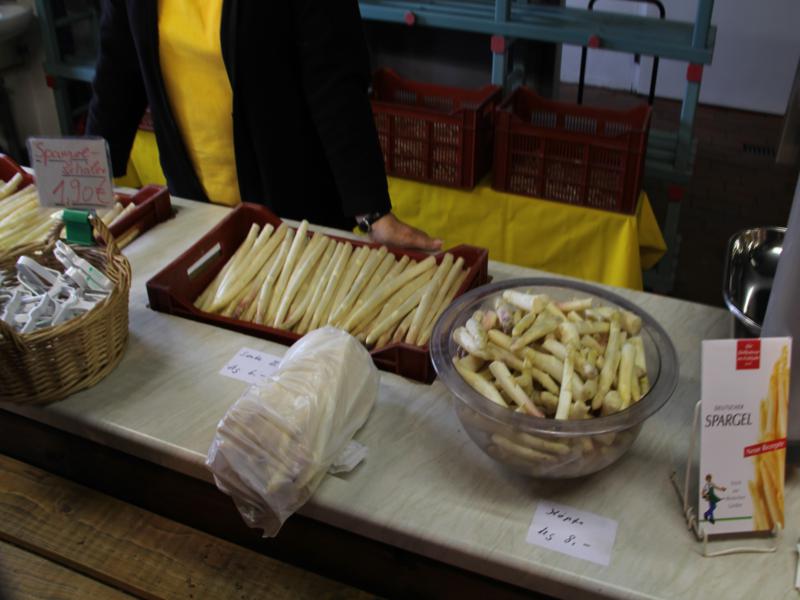
White asparagus sold from the farm in Germany
The German asparagus season is short, running from mid-April (depending on temperatures), until the 24 June, Johannes Day (John the Baptist Day). During this period, more asparagus is eaten per capita in Germany than almost every other country (Switzerland currently holds the record). But asparagus has a greater meaning for the Germans, it celebrates the spring season and arrival of warmer weather.
Large numbers of boxed asparagus can be seen in supermarkets, grocers, markets, temporary stalls at the side of the road and at numerous local farms. Germans pay large sums for these fresh, tight-headed, succulent, ivory spears, which they prefer to source in the local area. The asparagus is carefully graded. The best, plumpest spears are called ‘extra spargel’ and must be no less than 1.2cm in diameter, with tight heads and a velvety texture.

White and green asparagus
White asparagus
White asparagus is not a separate cultivar or variety, but simply the result of specific horticultural practices that take both time and care, hence the premium price. Green spears are very occasionally seen but are not as popular as the white.
Traditionally soil is heaped up some 30 cm (1 foot) high over the crowns of the asparagus plants over winter. Called ‘hillings’, they ensure no light gets to the tender young shoots. Commercially, rows are also covered with white plastic to ensure increased darkness, protection and also additional warmth.
White asparagus is always harvested by hand. There is an art to finding, gently unearthing, and then carefully cutting the tender young shoots with a special knife. I noted that the soils where the plants are grown are generally very sandy and hence provide good drainage.
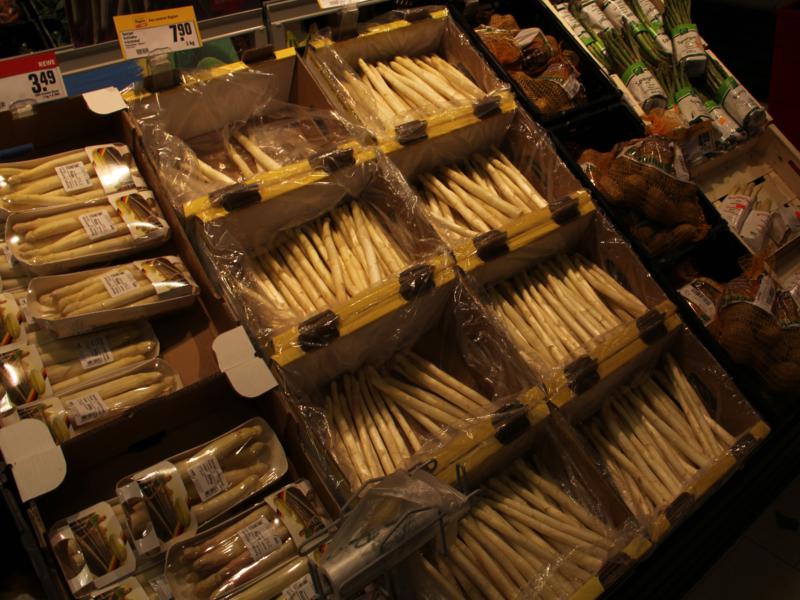
White asparagus at the grocers
Asparagus is one of my favourite vegetables and so I was very pleased to be in Germany during Spargalzeit and enjoy eating this iconic vegetable. I had met many people and read numerous articles that were quite dismissive of the white spears and claimed there was no difference, other than colour, between these and the more common green spears. This is not what I remembered, nor what I would have expected, given that many vegetables are blanched by excluding light to make them more sweet and tender. I was keen to try white asparagus once again to confirm my memories of a differently flavoured vegetable.
I will now place on record that following various tastings, I consider that white asparagus has a different flavor and texture to the more common green shoots. The shoots are softer, lighter and slightly more stringy in texture. The flavor is milder. But of course the colour also delights the eye, enhancing the presentation of the vegetable.
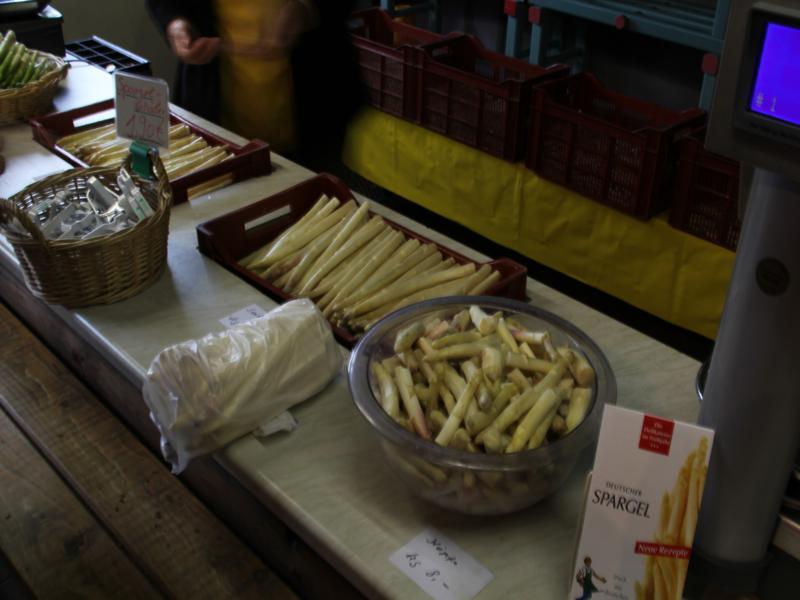
White asparagus sold from the farm. Note the aparagus peelers to the left
Another difference is that the white spears need to be peeled before serving, for the skins are a little coarser and have a slightly bitter flavor. A special asparagus peeler (or alternatively a potato peeler) can be used. Start preparation by snapping off the harder base of the stems. Then peel off the skin, starting from below the tip and working to the base using the peeler. Asparagus officianados have special asparagus steamers (spargeltopf) that steam the spears gently. The shoots are traditionally cooked with the peelings, a knob of butter, a sprinkling of sugar and a squeeze of lemon juice. Cook until just tender, which is usually some 10 to 15 minutes.
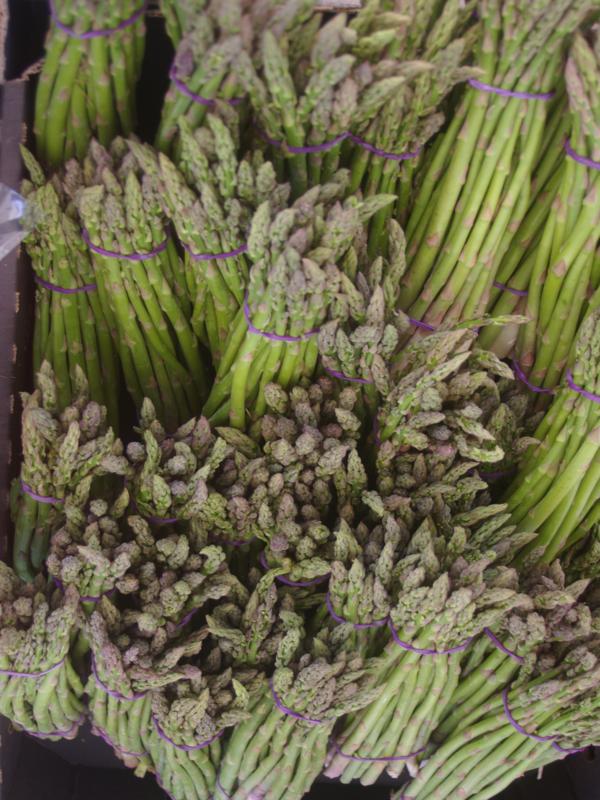
Delicious green asparagus at my local market
I also enjoy green asparagus and appreciate that the stronger flavor and crisper texture of these shoots which are better suited to more stongly flavoured dishes or textural dishes. However the milder white spears offer a different flavor to build a recipe upon. Whilst not generally available outside of Germany and Switzerland, the gardener has the option to grow these pale spears themselves.
In Germany, white asparagus is traditionally dressed with hollandaise sauce or melted butter, which do not overpower the delicate flavor. While it is the focus of any meal, it is often served with moist, yellow potatoes or pancakes (south Germany); ham, bacon or smoked salmon; and teamed with a carefully selected white wine.
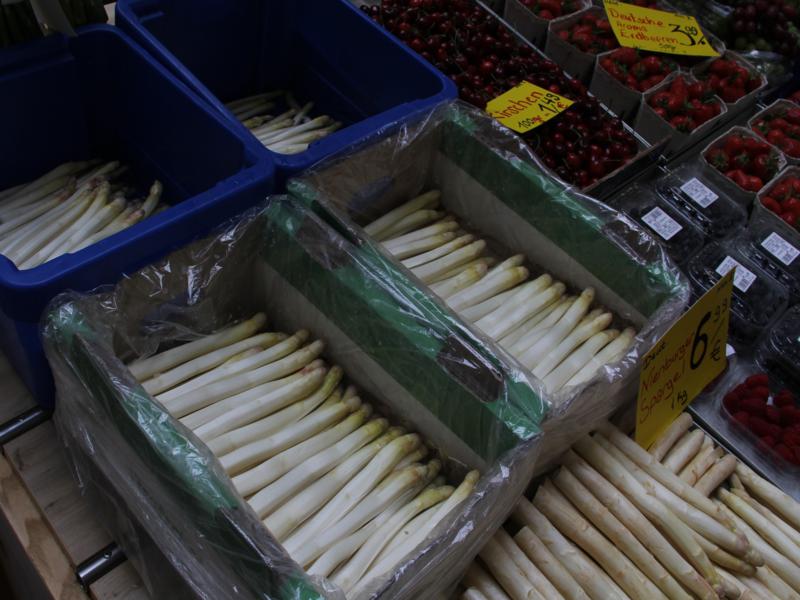
White asparagus at the supermarket
Growing asparagus
If you, like me, enjoy eating asparagus, it will be an essential vegetable in the garden. I think asparagus is one of the best vegetables for the busy, lazy or novice gardener. It is a very hardy and low maintenance plant. I once had a neighbor who had a plant in the garden planted by his mother some 50 years earlier. He never did anything to it and it continued to produce regularly – albeit the shoots were a little small and scrawny.
Of Eastern Mediterranean origin, asparagus has been eaten and grown since Ancient Egyptian times. It is one of those very rare plants that grows well in a diverse range of climates, including cool temperate, warm temperate, Mediterranean and subtropical. With good care, it can even be grown in many areas of the tropics.
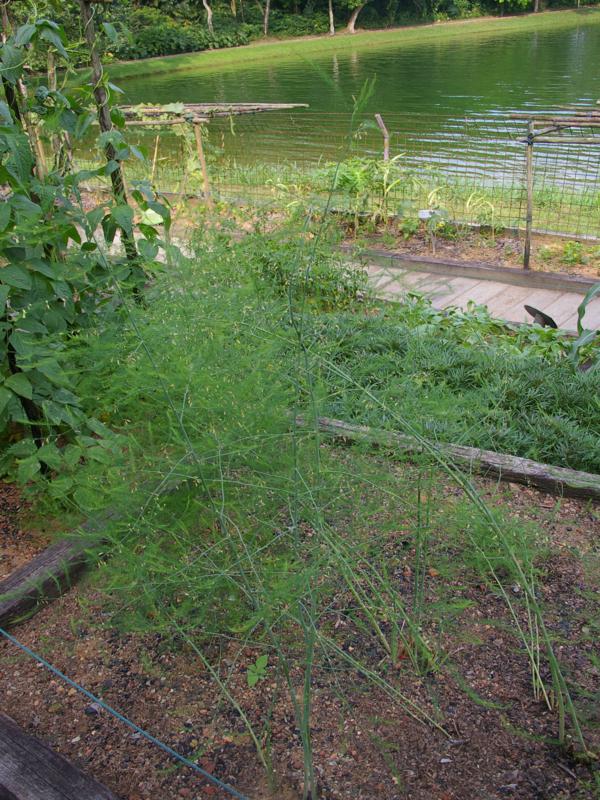
An asparagus in the Singapore zoo
Asparagus is considered a coastal plant. It grows well in sandy soils that have been well amended with organic matter. It also responds to regular nutrition, benefitting from the application of balanced ground rock minerals and manures. I know many people who swear by the use of fish manures or burying fish heads and offal nearby.
A row of 4 or 5 plants will ensure the family has plenty of succulent shoots each spring. Plant the crowns some 75 cm (30 inches) apart and allow each plant an area of some 1.5 metres (5 feet) in diameter during the growing season. If space is limited, you can tie the stems loosely together once they have matured to reduce the plants spread. Remember that asparagus is quite ornamental and where space is limited can be planted in many areas of the garden.
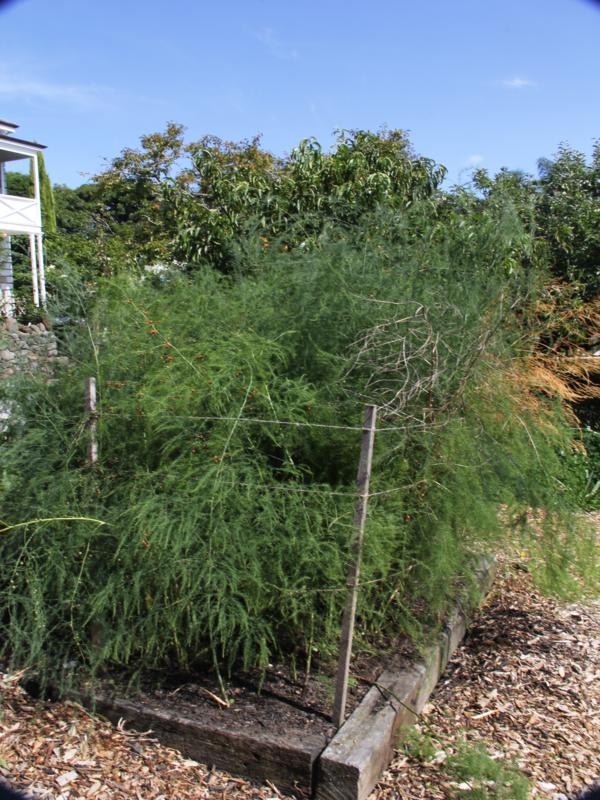
Asparagus plants can be tied back once the stems have hardened
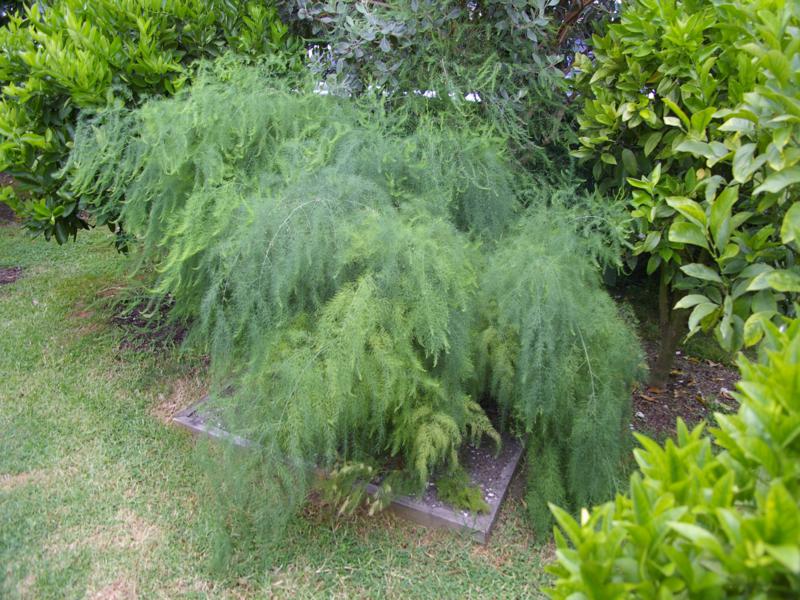
Asparagus doesn’t need to be grown in the vegetable garden. This plant is in an orchard area
Water during extended dry periods to ensure vigorous growth and large tender shoots. In wet climates or tropical and subtropical climates with summer dominant rainfall, good drainage is essential. On heavy clay or poorly drained soils, plants can be established in raised beds.
Another secret to growing quantities of plump shoots is not to be too greedy or extend the harvest season for too long. Depending on your climate zone, shoots will appear and can be harvested for a period of some 2 months from August to September (southern hemisphere) or April to June (northern hemisphere). The early shoots will be large, plump and succulent but as they become smaller and skinnier, this is a signal that the plant is losing vigor, the season is over and shoots should be left on the plant to grow over the summer period and nourish the plant and store nutrients in the rootstock. Newly planted crowns should be left at least 2 years before the harvest commences so they are well established. During extended dry periods water plants regularly to ensure they do not set back.
In cooler climates plants die off with the onset of frosts and cooler weather. In tropical and subtropical areas this may not occur and plants benefit from a cut back and mulch at the beginning of winter. Once plants are well established and producing well, with care it is possible to get a second autumn crop in subtropical and mild warm temperate climates. A plant can be cut back in autumn and produce a smaller crop of smaller shoots. As this might impact on spring production and plant vigour, it is recommended that plants are well cared for and growing vigorously and that this is done infrequently. Perhaps this occurs only once every 5 years on 1 individual plant. After 5 to 10 years, asparagus plants benefit from lifting, dividing and replanting in freshly prepared soil.
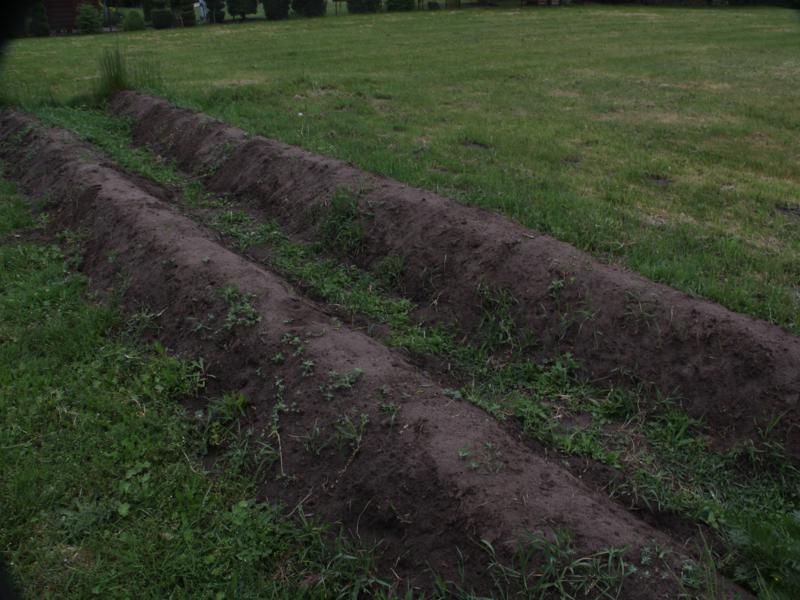
Florian’s white asparagus beds, currently in full production Langenhagen
I got to visit a home asparagus bed in full production. It looks like two longitudinal mounds of earth, but Florian heads out each afternoon at 6.00 pm to harvest fresh white spears. You might like to try something similar. Hill up loose soil or mulch over the crowns during winter to a height of some 30 cm high. Once shoots start to appear, carefully locate and cut them before they penetrate through the mound. This will involve daily examination, both visual and tactile (digging very gently with fingers) to find those fat white shoots.
Asparagus crowns or young plants are available in spring. These are generally ‘Mary Washington’, which is a popular, hardy, reliable cultivar. An increased range of different cultivars can be grown from seed. Cultivars with purple shoots can add interest to spring table. There are also cultivars with fatter, larger shoots. Recently I have seen seeds offered for wild clones and related asparagus species, which provide further diversity and an extended season.
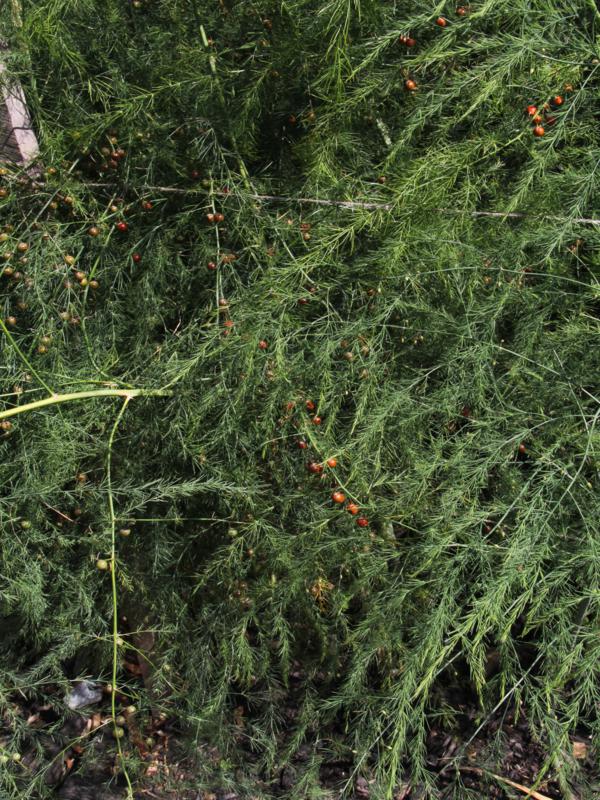
A female asparagus plant with red berries
Asparagus is easy to grow from seed and it is good to replenish established plants by having some young vigorous plants coming on which will start producing in 3 to 4 years. Asparagus plants are either male or female. Where both are grown, female plants will produce red berries towards the end of summer, each containing 1 or 2 seeds. These can be planted in prepared beds some ½ cm below the surface and watered regularly. In cool temperate, warm temperate and Mediterranean climates, sow seeds in spring, once the ground has warmed. In tropical and subtropical climates, sow in autumn once the ground has cooled.
Fresh is definitely best and fresh asparagus from the garden is far superior to the freshest you can buy. There is nothing like fresh asparagus, picked raw and eaten in the garden. The trick to the tastiest spears is to cut them just before cooking and serving. If not cooking and serving spears immediately, wrap them in a barely damp towel and refrigerate.
Now that winter is here (southern hemisphere) it is time to trim off the foliage to ground level. You might also consider trying some white asparagus and mounding some mulch or loose sandy soil over a plant.
If you do happen to be in Germany during spring, make sure you celebrate the asparagus season and enjoy this delicious vegetable. You might even like to travel along the designated ‘asparagus routes’ and try various dishes in recommended restaurants.
